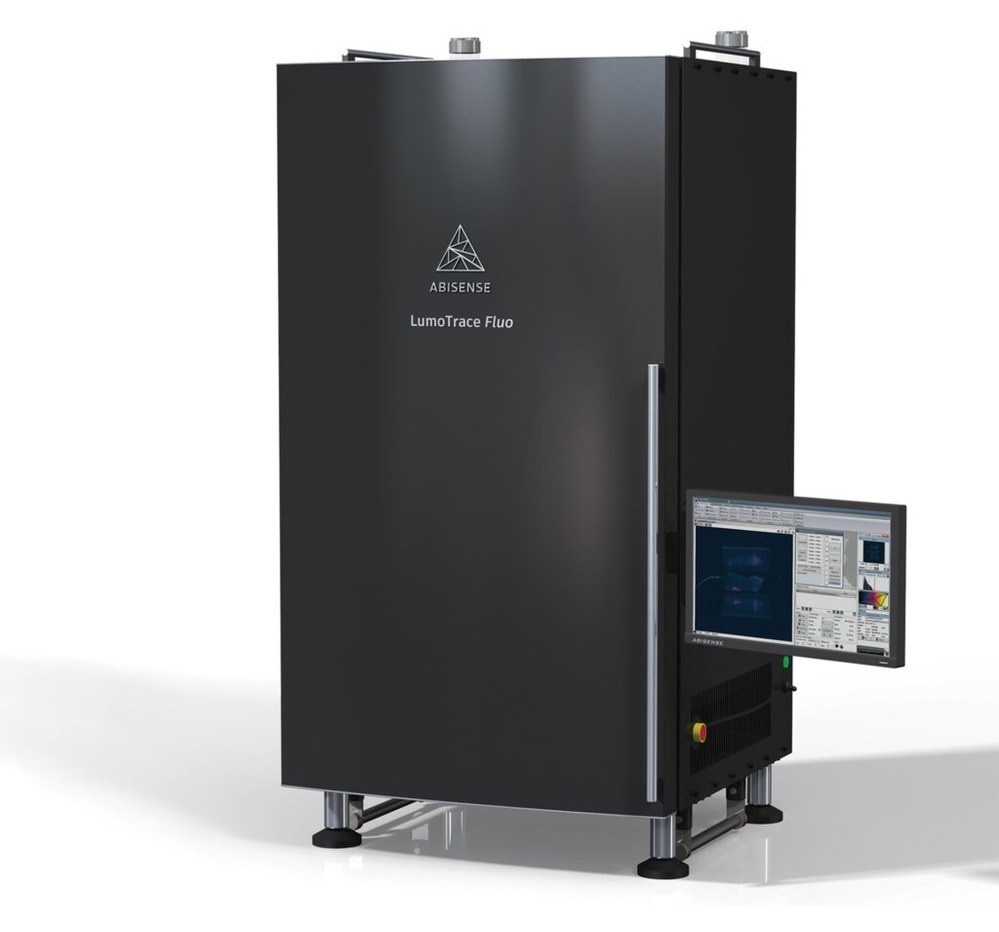Catalog
Equipment
2226 products
View:
- Selected: 0Areas of use
- Selected: 0Item names
- Selected: 0Manufacturer
- Selected: 0Made in
- Selected: 0Additional
View:
2226 products
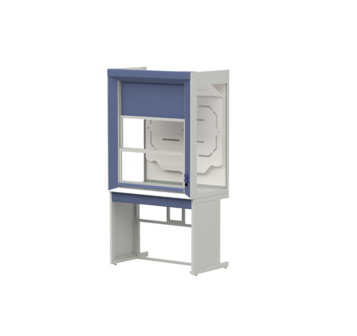
General purpose exhaust cabinet LAB-PRO SHV 120.84.230 SS
BASIC EQUIPMENT
Working box
guide racks – aluminum profile painted with powder paint (RAL 7035/RAL 5023)in the right rack there are a light switch and 2 splash-proof sockets with a 3.2kW cover (IP54)
the front anti–spill side is acid-resistant polished stainless steel AISI 304
side panels – tempered glass
2 dependent lifting screens – tempered glass in aluminum frames, lifting 0-780mm, do not change the dimensions of the cabinet when lifting
the upper fixed screen – metal painted with powder paint (RAL 5023) with the texture of shagreen leather
on the upper panel:
LED lamp dust- and moisture-proof (10W IP65)
switching box with automatic emergency power off 16A
flange d=250mm (the distance from the back panel to the center of the flange is 170mm)
easily removable exhaust canopies
3 levels of exhaust (lower, side and front)
counterweights are placed in the front pillars-pylons and are easily serviced
by the rear and upper panels – polypropylene
Frame base
collapsible frame made of rectangular metal profile painted with powder paint (RAL 7035) with the texture of shagreen leather
service panel - metal box painted with powder paint (RAL 5023) with the texture of shagreen leather:
adjustable supports
LOIP
Saint Petersburg
Produced in: Saint Petersburg
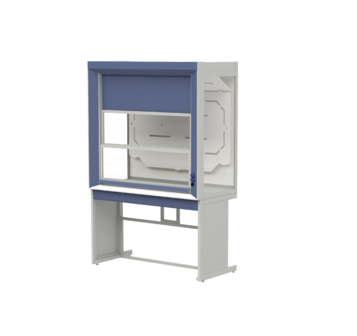
General purpose exhaust cabinet LAB-PRO SHV 150.84.230 KG
BASIC EQUIPMENT
Working box
guide racks – aluminum profile painted with powder paint (RAL 7035/RAL 5023)in the right rack there are a light switch and 2 splash–proof sockets with a 3.2kW cover (IP54)
the front anti-spill side is acid-resistant polished stainless steel AISI 304
side panels – tempered glass
2 dependent lifting screens – tempered glass in aluminum frames, lifting 0-780mm, do not change the dimensions of the cabinet when lifting
the upper fixed screen – metal painted with powder paint (RAL 5023) with the texture of shagreen leather
back and top panels –
polypropylene LED lamp dust- and moisture-proof (22W IP65)
switching box with automatic emergency power off 16A
flange d=250mm (the distance from the rear panel to the center of the flange is 170mm)
easily removable exhaust visors
3 exhaust levels (lower, side and front)
counterweights are placed in the front pylon racks and are easily serviced
Frame base
collapsible frame made of rectangular metal profile painted with powder paint (RAL 7035) with the texture of shagreen leather
service panel – metal box painted with powder paint (RAL 5023) with the texture of shagreen leather:
adjustable supports
LOIP
Saint Petersburg
Produced in: Saint Petersburg

General purpose exhaust cabinet LAB-PRO SHV 150.74.230 SS
BASIC EQUIPMENT
Working box
guide racks – aluminum profile painted with powder paint (RAL 7035/RAL 5023)in the right rack there are a light switch and 2 splash-proof sockets with a 3.2kW cover (IP54)
the front anti–spill side is acid-resistant polished stainless steel AISI 304
side panels – tempered glass
2 dependent lifting screens – tempered glass in aluminum frames, lifting 0-780mm, do not change the dimensions of the cabinet when lifting
the upper fixed screen – metal painted with powder paint (RAL 5023) with the texture of shagreen leather
on the top panel:
LED lamp dust- and moisture-proof (22W IP65)
switching box with automatic emergency power off 16A
flange d=250mm (the distance from the back panel to the center of the flange is 170mm)
easily removable exhaust canopies
3 levels of exhaust (lower, side and front)
counterweights are placed in the front pillars-pylons and are easily serviced
by the rear and upper panels – polypropylene
Frame base
collapsible frame made of rectangular metal profile painted with powder paint (RAL 7035) with the texture of shagreen leather
service panel - metal box painted with powder paint (RAL 5023) with the texture of shagreen leather:
adjustable supports
LOIP
Saint Petersburg
Produced in: Saint Petersburg
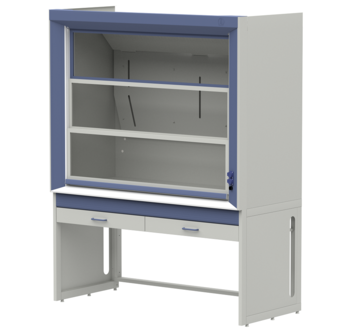
Exhaust cabinet for working with LVZH LAB-PRO SHVLVZH-D 180.84.230 KG
BASIC EQUIPMENT
Working box
front guide posts – aluminum profile painted with powder paint (RAL 7035/RAL 5023), in the right rack there are a light switch and 2 splash–proof sockets with a 3.2kW cover (IP54)
the front anti-spill side is acid-resistant polished stainless steel. AISI 304 steel
rear, upper, side panels – metal painted with powder paint (RAL 7035)
with the texture of shagreen leather
2 dependent lifting screens – tempered glass in aluminum frames, lifting 0-780mm, do not change the dimensions of the cabinet when lifting
the upper fixed screen – tempered glass in an aluminum frame
on the top panel:
4 anti-explosion valves
LED dust- and moisture-proof lamp 2x22 W (IP65) is separated from the workspace by tempered glass thickness of 4mm
flange d=250mm (distance from the back panel to the center of the flange – 170mm)
3 levels of exhaust
on the rear panel:
4 holes d =22mm with plugs made of stainless steel for installing additional pipes or taps
technological hole d=50mm with a plastic plug
counterweights are placed in the front pillars-pylons and are easily serviced
Frame base
collapsible frame made of rectangular metal profile painted with powder paint (RAL 7035) with the texture of shagreen leather
service panel - aluminum profile painted with powder paint (RAL 5023) with the texture of shagreen leather
module with two drawers
LOIP
Saint Petersburg
Produced in: Saint Petersburg
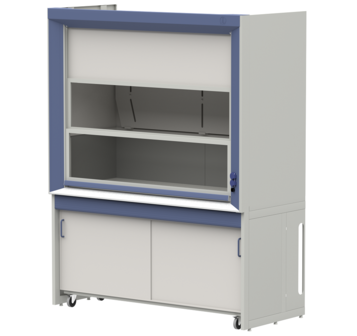
Exhaust cabinet for working with acids LAB-PRO SHVK 180.84.230 VI
BASIC EQUIPMENT:
Working box
front guide posts – aluminum profile painted with powder paint (RAL 7035/RAL 5023), in the right rack there are a light switch and 2 splash–proof sockets with a 3.2kW cover (IP54)
the front anti-spill side is acid-resistant polished stainless steel. AISI 316 steel
rear, upper, side panels – metal painted with powder paint (RAL 7035) with the texture of shagreen leather
inner capsule made of polypropylene lined with ceramic plates of the rear and side panels to a height of 380mm
2 dependent lifting screens – tempered glass in aluminum frames, lifting 0-780mm, do not change the dimensions of the cabinet when lifting
the upper fixed screen – polypropylene
on the upper panel:
the LED lamp is dust- and moisture-proof 2x22 W (IP65) is separated from the workspace by tempered glass with a thickness of 4mm
flange d=250mm (distance from the back panel to the center of the flange – 170mm)
switching box with automatic emergency power off 16A
3 exhaust levels
easily removable exhaust visors
counterweights are placed in the front pylon racks and are easily serviced
Frame base
collapsible frame made of rectangular metal profile painted with powder paint (RAL 7035) with the texture of shagreen leather
service panel - aluminum profile painted with powder paint (RAL 5023) with the texture of shagreen leather
adjustable supports
LOIP
Saint Petersburg
Produced in: Saint Petersburg
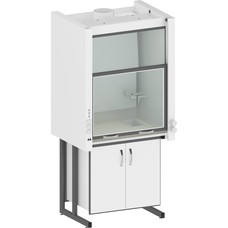
Fume Cupboard SHV-NRZH.100
Overall dimensions with raised protective shield 1005x800x2270 mm
Overall dimensions with lowered protective screen 1005x800x2100 mm
The diameter of the exhaust pipe is 200 mm
Weight 160 kg
Power supply 220 V, 50 Hz, 16 A
Termeks
Tomsk
Produced in: Tomsk
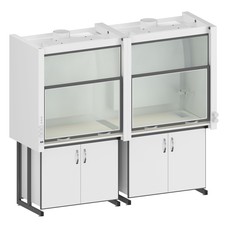
Fume Cupboard SHV-NRZH.240
Overall dimensions with raised protective shield 2405x800x2270 mm
Overall dimensions with lowered protective shield 2405x800x2100 mm
The diameter of the exhaust pipe is 200 mm
Weight 386 kg
Power supply 220 V, 50 Hz, 16 A
Termeks
Tomsk
Produced in: Tomsk
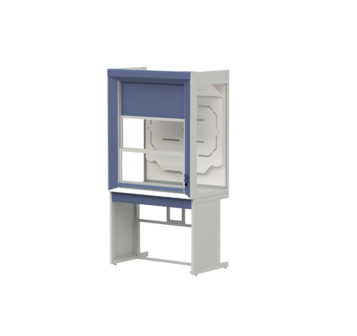
General purpose exhaust cabinet LAB-PRO SHV 120.74.230 SS
BASIC EQUIPMENT
Working box
guide racks – aluminum profile painted with powder paint (RAL 7035/RAL 5023)in the right rack there are a light switch and 2 splash–proof sockets with a 3.2kW cover (IP54)
the front anti-spill side is acid-resistant polished stainless steel AISI 304
side panels – tempered glass
2 dependent lifting screens – tempered glass in aluminum frames, lifting 0-780mm, do not change the dimensions of the cabinet when lifting
the upper fixed screen – metal painted with powder paint (RAL 5023) with the texture of shagreen leather
on the top panel:
LED lamp dust- and moisture-proof (10W IP65)
switching box with automatic emergency power off 16A
flange d=250mm (the distance from the back panel to the center of the flange is 170mm)
easily removable exhaust canopies
3 levels of exhaust (lower, side and front)
counterweights are placed in the front pylon racks and are easily serviced
by the rear and upper panels – polypropylene
Frame base
collapsible frame made of rectangular metal profile painted with powder paint (RAL 7035) with the texture of shagreen leather
service panel - metal box painted with powder paint (RAL 5023) with the texture of shagreen leather:
adjustable supports
LOIP
Saint Petersburg
Produced in: Saint Petersburg
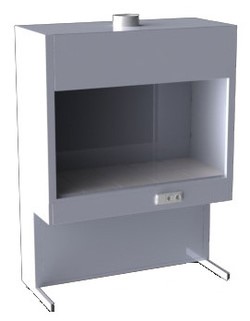
Exhaust cabinet for muffle furnaces Mod. -1500 SHVMP
from
131 472 ₽
The side, back walls and top are made of sheet metal. Automatic emergency power cut-off (16 A), two splash-proof sockets, a light-switch, an electrical box on the base panel's back. Flange to connect to exhaust system of ventilation (200 mm).
The cabinat's base is a relocatable reinforced frame made of steel shaped tube on adjustable bearings.
The exhaust box and the cabinet's base are painted with high-quality powder polymer paint, that protects the cabinet from the external effects of aggressive vapors, mechanical damage and high temperatures.
Additionally, the cabinet can be equipped with a metal box for other supplementary equipment storage, consumables, tools.
PK "Sovremennaya Laboratoriya"
Saint Petersburg
Produced in: Saint Petersburg
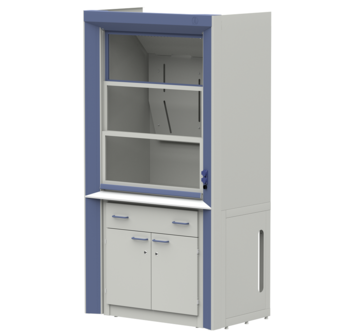
Exhaust cabinet for working with LVZH LAB-PRO SHVLVZH-TB 120.74.230 KG
BASIC EQUIPMENT
Working box
front guide posts – aluminum profile painted with powder paint (RAL 7035/RAL 5023), in the right rack there are a light switch and 2 splash–proof sockets with a 3.2kW cover (IP54)
the front anti-spill side is acid-resistant polished stainless steel. AISI 304 steel
rear, upper, side panels – metal painted with powder paint (RAL 7035) with the texture of shagreen leather
2 dependent lifting screens – tempered glass in aluminum frames, lifting 0-780mm, do not change the dimensions of the cabinet when lifting
the upper fixed screen – tempered glass in an aluminum frame
on the top panel:
4 anti-explosion valves
LED dust- and moisture-proof lamp (2x10W IP65) is separated from the workspace by tempered glass thickness of 4mm
flange d=250mm (distance from rear panel to the center of the flange – 170mm)
switching box with automatic emergency power off 16A
easily removable exhaust visors
3 levels of exhaust
on the rear panel:
technological hole d = 60mm with a plastic plug
counterweights are placed in the front pillars-pylons and are easily serviced
Frame base
collapsible frame made of rectangular metal profile painted with powder paint (RAL 7035) with the texture of shagreen leather
front pillars - aluminum profile painted with powder paint (RAL 7035/RAL 5023)
adjustable supports
LOIP
Saint Petersburg
Produced in: Saint Petersburg
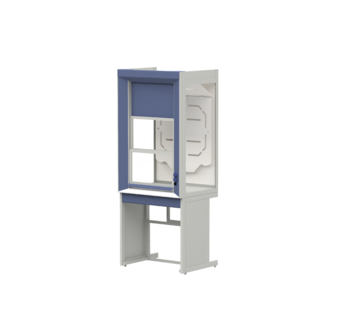
General purpose exhaust cabinet LAB-PRO SHV 90.84.230 SS
BASIC EQUIPMENT
Working box
guide racks – aluminum profile painted with powder paint (RAL 7035/RAL 5023)in the right rack there are a light switch and 2 splash-proof sockets with a 3.2kW cover (IP54)
the front anti–spill side is acid-resistant polished stainless steel AISI 304
side panels – tempered glass
2 dependent lifting screens – tempered glass in aluminum frames, lifting 0-780mm, do not change the dimensions of the cabinet when lifting
the upper fixed screen – metal painted with powder paint (RAL 5023) with the texture of shagreen leather
on the top panel:
LED lamp dust- and moisture-proof (10W IP65)
switching box with automatic emergency power off 16A
flange d=250mm (the distance from the back panel to the center of the flange is 170mm)
easily removable exhaust canopies
3 levels of exhaust (lower, side and front)
counterweights are placed in the front pillars-pylons and are easily serviced
by the rear and upper panels – polypropylene
The frame base
is a collapsible frame made of a rectangular metal profile painted with powder paint (RAL 7035) with the texture of shagreen leather
service panel is a metal box painted with powder paint (RAL 5023) with the texture of shagreen leather:
adjustable supports.
LOIP
Saint Petersburg
Produced in: Saint Petersburg
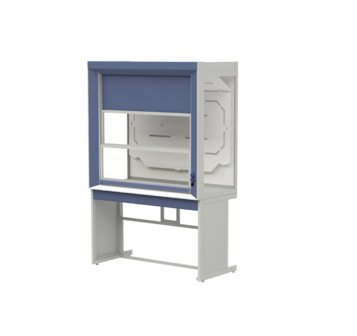
General purpose exhaust cabinet LAB-PRO SHV 150.84.230 TR
BASIC EQUIPMENT
Working box
guide racks – aluminum profile painted with powder paint (RAL 7035/RAL 5023)in the right rack there are a light switch and 2 splash–proof sockets with a 3.2kW cover (IP54)
the front anti-spill side is acid-resistant polished stainless steel AISI 304
side panels – tempered glass
2 dependent lifting screens – tempered glass in aluminum frames, lifting 0-780mm, do not change the dimensions of the cabinet when lifting
the upper fixed screen – metal painted with powder paint (RAL 5023) with the texture of shagreen leather
back and top panels –
polypropylene LED lamp dust- and moisture-proof (22W IP65)
switching box with automatic emergency power off 16A
flange d=250mm (the distance from the back panel to the center of the flange is 170mm)
easily removable exhaust visors
3 exhaust levels (lower, side and front)
counterweights are placed in the front pylon racks and are easily serviced
Frame base
collapsible frame made of rectangular metal profile painted with powder paint (RAL 7035) with the texture of shagreen leather
service panel – metal box painted with powder paint (RAL 5023) with the texture of shagreen leather:
adjustable supports.
LOIP
Saint Petersburg
Produced in: Saint Petersburg
